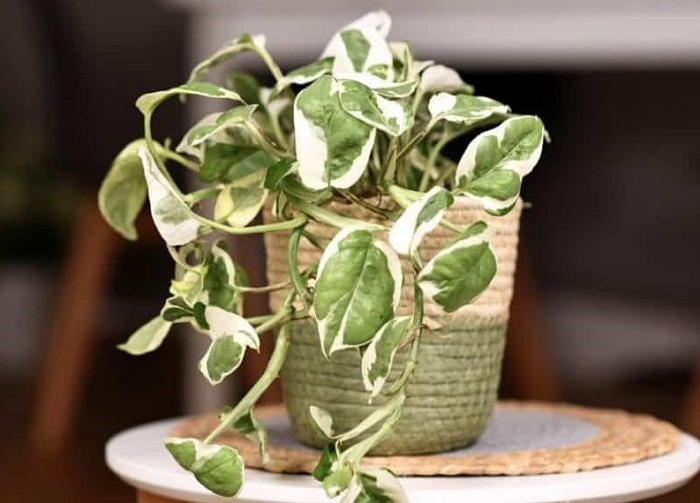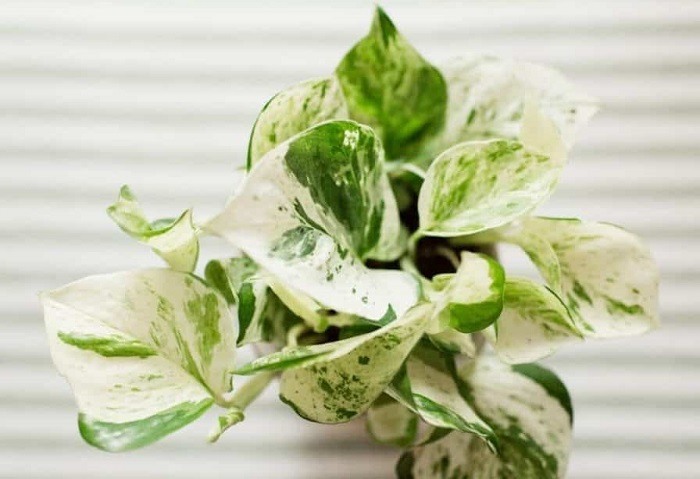Pothos plants are the most popular houseplants in the world. These indoor plants are affordable, versatile, and can endure almost all conditions. Pothos N joy vs peals and jade have close similarities that confuse many houseplant enthusiasts.
So, what is the main difference between pothos N joy and pearls and jade? Pothos N Joy foliages have a white background and darker green variegation, while pothos pearls and jade foliages have a few blotches of green, white, and grey coloration.
Continue reading this comparison guide to learn other hidden differences and similarities between these two beautiful pothos species. The information also highlights a few tips on pothos pearls and jade care.
You May Also Like: Philodendron Lemon Lime Vs Neon Pothos
Comparison Table (Pothos N Joy Vs Pearls and Jade)
| Basic Terms | Pothos N Joy | Pearls and Jade |
| Origin | Unnamed marble queen superior clone. | Group of marble queen plants. |
| Leaf Shape | Smaller, broader, and ovate leaves. | Elongated heart-shaped leaves. |
| Leaf Size | 2 inches long and 1.5 inches wide. | 3 inches long and 1.5 inches wide |
| Leaf Color | White background with dark green variegation. | Combination of a few blotches of white, green, and grey. |
| Maximum Height | 2 inches long | 3 inches long |
| Light Conditions | Tolerant to different light conditions. | Not resilient to different light conditions. |
| Leaf Texture | The top surface feels waxy and smooth. Have leathery undersides. | The top feels like paper in thickness and appearance. |
What Is Pothos N Joy?

N joy pothos is a cultivar originating from unnamed marble queen pothos. The pothos species hails from Australia and Southeast Asia. But the cultivar originates from the United States.
The pothos N joy can grow up to 6-9 inches indoor and climb up to 10 feet. The trailing stems tend to root when they come into contact with soil.
N joy pothos thrives in bright indirect sunlight and rarely bloom. Low light conditions can cause the variegation to fade. Besides that, these pothos species need little water to survive.
Pothos N Joy requires minimal pruning and maintenance. The pruning routine is ideal for removing leggy stems and enhancing compact design.
Wipe the leaves with alcohol or neem oil monthly to remove dust and prevent pest infestations. It also helps the plant to remain healthy for an extended period.
You May Also Like: How to Care for China Doll Plant
What Are Pearls and Jade?

Pearls and jade is a member of marble queen pothos. The plant is not only beautiful but also an avid climber. It has variegated grey-green leaves covered in cream, grey, and white streaks.
The houseplant resembles its cousin satin pothos. The indoor plant originates from Solomon Island in the United States.
Pearls and jade has an average length of 6-10 feet and climbs up to 30 feet under appropriate conditions. The trailing stems are not supported by aerial roots like in the pothos N joy plant.
The pothos species can tolerate low light conditions for a couple of days, though it thrives in bright indirect sunlight. It also loves slightly moist potting soil.
Every plant parent will need to prune pearls and jade to keep it looking nice and full. Be sure to prune leggy stems to produce a fuller pothos plant.
You Might Also Enjoy: How to Care for Alocasia Frydek
Differences between Pothos N Joy, Pearls and Jade
Leaf Shape and Texture
N joy pothos plants have smaller and broader leaves with small stem internodes. The species produce more than two green shades within its variegation.
Pearls and jade plants have elongated heart-shaped leaves like petite. The top surface feels like paper due to its consistency and thinness.
Growth Habit
Both N joy and pearls and jade are climbing plants. They can reach great length in their natural habitat and rarely exceeds 1 to 2 feet tall when grown in a room.
N joy pothos internodes are about 2 inches long, while those of pearls and jade pothos are slightly longer than 3 inches. Use pole moss (Check Best Deals on Amazon) to support them.
Foliage Color
Pothos N Joy leaves have white background covered in various green shades on the upper surface. The foliages may change color to yellow-green and dark green under low light.
Pearls and jade foliages have a combination of green, white, and streaks of grey coloration. The underside of each leaf has a leathery appearance.
Light Requirements
Natural sunlight is an essential factor for these pothos varieties. It enables the plant to carry out its physiological activities like photosynthesis.
Pearls and jade are less resilient under different lighting conditions. But pothos N joy can tolerate low light and bright indirect sunlight without any problem.
Height and Structure
N Joy pothos is a slow-growing tropical plant. It grows to a height of 15-25cm and spreads out to 25-30cm under appropriate conditions.
Pearls and jade can attain a maximum height of around 7.4-8.7 inches with a leaf size range of 2.6-2.8cm. It is the best pothos species for hanging baskets.
Similarities between Pothos N Joy, Pearls and Jade
Soil Requirements
Both pothos N Joy and pearls and jade thrive in a well-draining potting mix. Avoid using soil due to pest infestations and pathogens.
Ensure the potting mix consists of peat moss, pumice, coco coir, orchid bark, and perlite. Peat moss helps to boost potting mix fertility and keep the roots moist.
Watering Needs
Both pothos species prefer a slightly and consistent moist potting mix. Irrigate both plants twice or thrice during hot summer and reduce the frequency in winter.
Overwatering increases the risk of root rot disease. The fungal disease has a high chance of killing your favorite houseplant.
Temperature and Humidity
Most pothos varieties thrive under a temperature range of 65-85oF (18-29oC) and a humidity range of 60-70%. Both hot and cold drafts can damage or harm your houseplant.
Use a humidifier to boost indoor humidity level and a digital thermometer to detect temperature changes. Appropriate temperature and humidity ensure these pothos plants stay happy.
Fertilizer Requirements
Both pothos species are light feeders. These indoor plants can thrive without fertilizer application. Use a balanced fertilizer to help improve the plant’s health and condition.
Feed these plants monthly during spring and summer. I recommend the use of homemade fertilizer to avoid issues related to over-fertilization.
Pests and Diseases
Both pothos plants are more vulnerable to aphids, spider mites, thrips, and mealybugs. These sap-sucking insects usually cause damage to the plants. Use isopropyl to eradicate them.
Besides that, improper ventilation and overwatering can result in fungal diseases. Use fungicides to treat the leaves affected by fungal conditions.
You May Also Read: 22 Pothos Varieties with Names and Pictures
Conclusion
Pothos N Joy is the best option for beginners and absentee plant parents due to its minimal maintenance requirements. It can tolerate drought and low light conditions for months.
Pearls and jade species have an aesthetic appearance that makes lasting impressions. The houseplant requires top-notch care and more attention.
Both N joy and pearls and jade are excellent houseplants due to their tropical vibes. They are ideal for shared living areas or offices.
